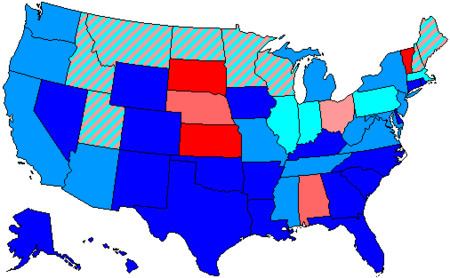258 seats 176 seats 37 36 57.1% 42.4% Start date November 3, 1964 | 295 140 37,643,960 27,916,576 4.7% 4.7% | |
 | ||
Winner John William M | ||
The 1964 United States House of Representatives elections was an election for the United States House of Representatives in 1964 which coincided with the election of President Lyndon Johnson. Johnson's landslide victory over Barry Goldwater allowed his Democratic Party to gain a net of 36 seats from the Republican Party, giving them a two-thirds majority in the House. This is the largest House majority held by either party since 1936. The election also marked the first time since Reconstruction that Republicans made inroads in the deep South.
Contents
Overall results
Summary of the November 3, 1964, election results
Southern significance
While the GOP performed badly nationally, Goldwater's tremendous success in the Deep South led to the election of several Republicans to the House from those states, many of them the first Republicans elected there since Reconstruction. These "Goldwater Republicans" were elected:
Alabama
Alabama, which had not agreed on a redistricting plan until 1964 and had elected all members at-large in 1962, went back to electing from districts. While most of the at-large representatives were former district representatives and were thus geographically diverse, the 1st district near Mobile lacked an incumbent, and neither of the incumbents who lived in the 7th district were nominated.
Connecticut
Connecticut eliminated its at-large seat and redistricted from 5 districts to 6, creating a new district in the northwestern part of the state.
Georgia
Georgia redistricted its existing 12 districts, dividing the Atlanta-area 5th district into a 4th and 5th district, renumbering the existing 4th district to the 6th, and dividing the existing central Georgia 6th district up between its neighbors with compensating boundary changes elsewhere.
Michigan
Michigan redistricted, converting its at-large seat into a 19th district and realigning the other districts to account for population growth in the Detroit suburbs. Two Democratic seats and one Republican seat were eliminated or combined at redistricting, but the defeat of three Republican incumbents and the election of Democrats to all the new seats yielded a net shift of four seats, changing the party balance from 11R-8D to 7R-12D.
Wisconsin
Wisconsin redistricted to adjust for demographic changes, merging the existing 9th district into the neighboring 3rd district in the west and forming a new 9th district in the Milwaukee suburbs with compensating boundary changes elsewhere.
